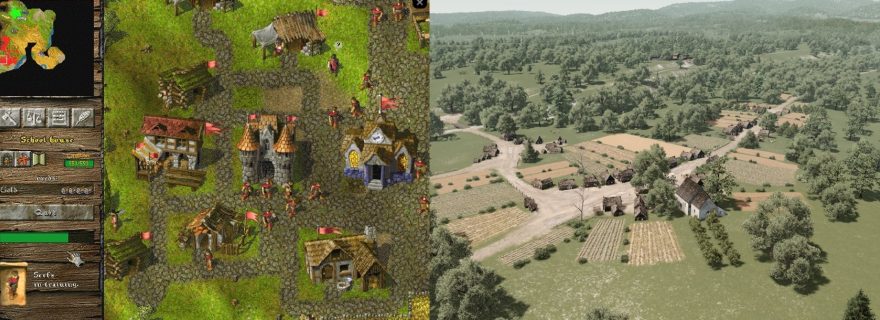Why medieval city-builder video games are historically inaccurate
This blog post explores the historical accuracy of medieval city-builder video games.
Introduction
Since many of us are working from home in these trying times, it seems safe to assume that more people than ever are indulging in playing the occasional computer game. A city builder is a specific kind of computer game in which you design a city, extract resources, set up production chains and ensure that your settlement grows. City builders are very similar to strategy games as they reward patience and strategy. In this article, I will take a look at one sub-genre of the city builder, the medieval city builder, and explain how this gaming genre relates to our knowledge of medieval settlement planning.
Historical city builders
The city builder has its origins far back in the 1990s in the combination of the strategy genre and the management genre, leading to games such as Sim City (1989), Caesar (1992) and Age of Empires (1997).
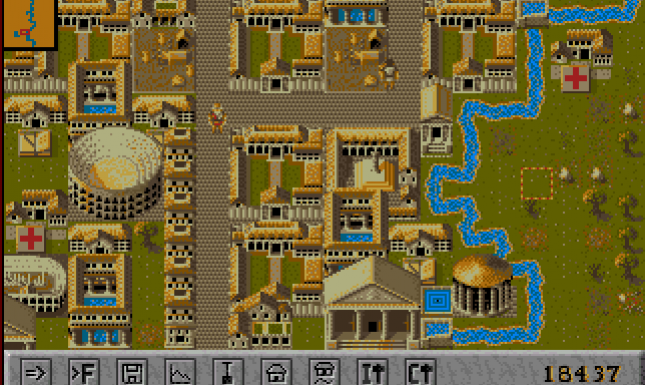
It did not take long before medieval-themed city builders popped up. We may think of Settlers (1993) and Knights and Merchants (1998). In addition, the Anno games (1998-2019), although initially set in the 1600s basically had a medieval theme.
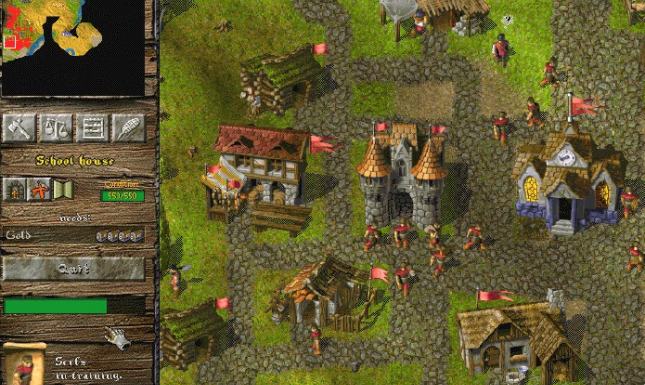
These games often start with plopping down a village center on a promising location near abundant resources. You then continue to gather these resources which grant you building materials for building new homes and facilities for your settlement.
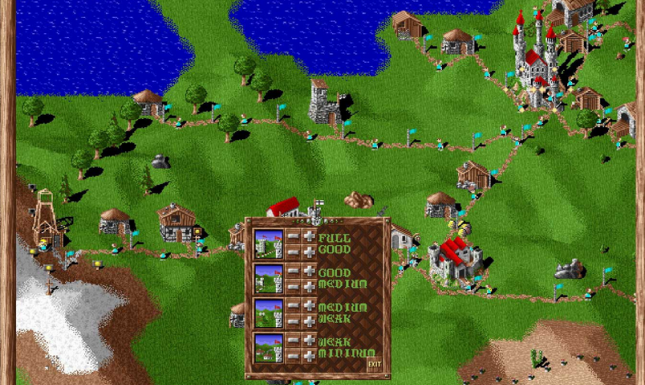
Setting up specialized production chains might involve growing grain, milling the grain for flour and turning the flour into bread which feeds your villages. Similarly, another production chain might involve rearing sheep for their wool, turning the wool into cloth and turning the cloth into clothing. When done correctly, the reward of correct investments and planning is that you see your settlement grow.
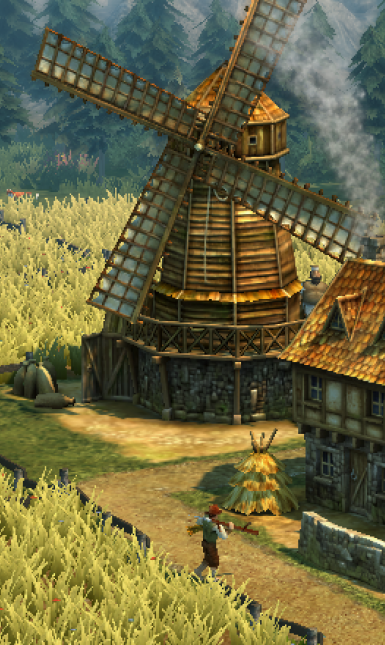
This often leads to settlements growing organically from a couple of houses around a community center to a larger settlement with hundreds of people. However logical such an organic growth of a settlement might seem, it is not historically accurate.
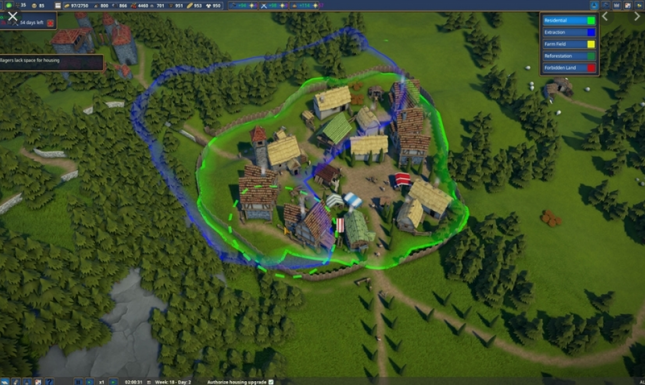
Medieval village life
Any gameplay loop that tells a story of linear settlement growth is incongruent with how a medieval economy worked (see Foussier 2004). Medieval villagers were often living on the edge of subsistence. Agricultural surpluses were skimmed by the church and the feudal lords. Bad harvests, banditry, warfare and disease might decimate a village community at any time. For this very reason, the demography of many European villages remained relatively stable between the twelfth and the eighteenth century. It may therefore be clear that the gameplay loop of city builders pivots around the concept of doing the historically exceptional (i.e. growing a settlement to a town) and thereby strays far from what actually happened in the lives of our medieval forebears.
A notable exception to this genre trope is the game Banished (2014) in which high mortality rates and bad weather do seriously stifle any kind of linear growth. In this city builder you are constantly fighting the odds and settlement growth is not guaranteed. However, also in Banished it is your goal to overcome the stagnation and lead your settlement to expansion.
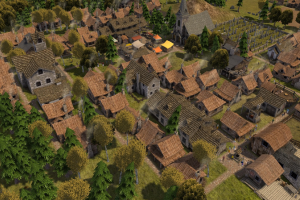
A thing that is rarely touched upon in medieval city builders is how complex village life actually was. This can be exemplified by how the community related to its overlords. Land ownership here is key. Land in the community might be owned by a lord, a local liegeman, a monastery or even directly by the duke or count. Taxes, rents and tithes were the organisational structures in which the landowner was tied to the farmers who worked the fields. Often the payment of taxes and tithes was linked to feast days and the visit of the tax collector represented a big event in the agricultural year. An interesting side note is that some obligations which the commoners had to the lord and the church (such as seigneurial duties like working a mill) might drain the community from the needed manpower for tilling the land. Furthermore, a rural community that was its own seigneury had access to a law court with sheriff, aldermen and a local militia (Middle Dutch schutterie) to fight off bandits with. Harsh capital punishments were set in place to deter anyone from raiding the farms and hamlets and the village gallows were often the first thing one saw when approaching a medieval settlement.
Planning a medieval settlement
But something that is much more fundamental to the theme of a settlement building game, is how medieval settlements were actually planned and grew. Landscape historians and archaeologists have acquired a lot of insight into how this worked.
Let's start with the realization that medieval settlements in their first stages of development were planned and laid out according to a specific design. In my own research into the settlement history of West-Brabant (southern Netherlands, from 1000 to 1300 CE) I have encountered the following types.
Here is a sketch of a Brabantine circular manor (Middle Dutch vroonhoeve). This is a reinforced circular homestead with moat, often next to a bend in the river, containing several farms and a fan-like plot pattern radiating out from it. Such manors were often called BORCH.


Here is a sketch of a Brabantine street settlement, often built with exploitation of nearby fenland in mind. It consists of a line of farms with associated evenly sized rectangular plots built in a line perpendicular to a raised road.


Here is a more complex exploitation village which is set up with a moated enclosed church homestead and a central meadow as its center. There is a line of farms next to the road. The arable land to the east is bordered by a ditch supplying fresh drinking water (Middle Dutch bansloot). In layout, this type represents a hybrid between the two earlier settlement types.
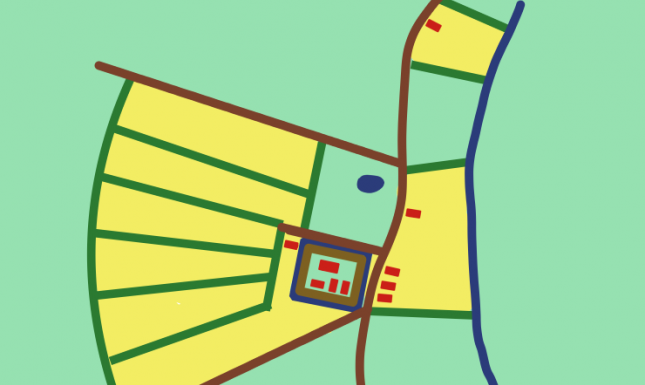

Let us first make clear that these different types of exploitation settlements often existed alongside each other and can be found in one and the same region. In part, the different types reflect different chronological layers but some types were also more suited to certain geographical environments than others.
So how were these settlements planned? Many medieval exploitation enterprises were initiated by a monastery or a consortium of free men who were granted permission by (or bought permission from) the feudal lord to “colonize” the wilderness.
Clearing the wooded landscape in order to create arable land was done by cutting away the trees and bushes (Middle Dutch rode) or, alternatively, burning it away in controlled fires (Middle Dutch brant).
Land surveyors sent by the lord would then measure out the block or strips that would be taken in cultivation. Strips of arable land were often 1250m deep (6 Middle Dutch voorlingen = furlongs) so that the plough could go straight in a long line before having to turn. Important blocks or strips were demarcated by hedges, earthwork, woodwork, ditches or roads. Medieval names for these blocks often survived into the modern day.
The presence of drinking water (a river or a brook) in the vicinity was an important factor in choosing the location for the settlement. The vicinity of water entailed risk and reward because flooding was an ever present danger. Floods could devastate arable land but might also fertilize it. Meadows in particular were often situated in flood areas.
Managing a settlement
So how was such a settlement managed? First of all, the quality of the soil had to be carefully controlled by crop rotation: specific crops were sown on different segments of the arable land with one part laying fallow to recover from the tilling (English three-field system, Dutch drieslagstelsel). The cattle and sheep were put out to pasture on the common meadows guarded by a shepherd or cowherd. Pigs were allowed to forage in the nearby forests and killed in autumn before the winter starvation set in.
Roads and rivers were important for transport of crops and livestock. These roads, some of them paved, some of them not, needed to be maintained. They were essential to the payment of the tithe, since tithe collectors assessed the harvest on the field and later collected the sheaves on the side of the road.
The buildings within the community also needed maintenance. Farmhouses, community barns and stables were made of wood and had to be rebuilt every few generations, only the name of the farm or homestead being continued.
So what kind of threats did a medieval settlement face? First of all, the weather was an important factor which dictated the success of the harvest. Storms, droughts and floods could devastate the harvest and decimate the community.
Diseases and epidemics were another danger threatening the community. The situation on the countryside was a lot better in this regard than in the medieval towns, but an epidemic could still mean the end of a village. Similarly, diseases among livestock impacted the medieval subsistence economy in a brutal way.
Then there are the consequences of medieval warfare affecting the community: Armies that passed by could plunder the village, burn the farms and execute villagers at will. Or they could also demand supplies, food and provisions as an emergency "tax"
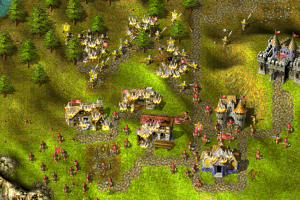
But war also brought indirect consequences; a liege lord calling the banners and levying troops from the village community might extract a large part of the adult men. Warfare also disrupted the trade networks that supplied a village with building materials and commodities.
Then there were internal threats to the fabric of the village community. We may think of social unrest because of land disputes. Feuds could also tear a community apart with endemic vendetta’s causing death and despair. A socially unstable society was also more prone to internal accusations of heresy and witchcraft.
An “accurate” medieval settlement builder
So, which of the above listed features could potentially contribute to a more historically accurate computer game about medieval settlement building? First of all, it would be more realistic if the settlement could first be planned out and was not forced to "grow organically" from a community center. The first settlement phase would be a test of how “successful” a layout is in adapting to the exigencies of the terrain and the needs of the community. Only after that initial layout proved successful, further expansions can be planned.
Secondly, it would be more realistic if we could build both straight roads and curved roads, just as in Cities Skylines (2015), a modern city builder well known for its incredibly flexible layout tools. Incidentally, the tools of Cities Skylines can also be used to recreate medieval settlements, as was done by YouTube creator Play Curiously who constructed an impression of a medieval Croatian village.
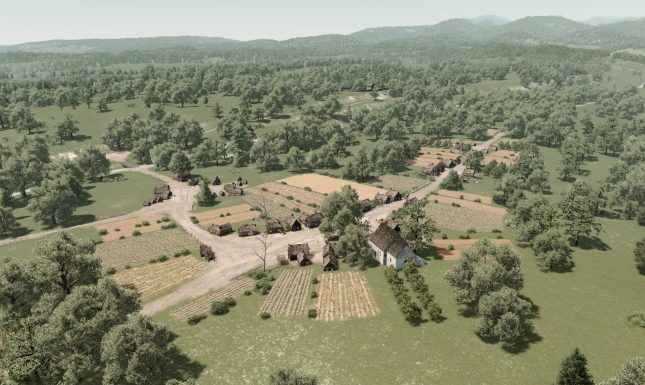
Such a flexible road drawing tool can then also be used to lay out ditches, hedges and enclosures since these features were central to the medieval experience of the cultivated landscape.
Thirdly, It would be interesting to see a medieval-themed game embrace the concept of flood valleys that limit and endanger pasture and arable land. Other historical city builders such as Pharaoh (1999) and Children of the Nile (2004) already implemented this feature for their setting in Ancient Egypt. However, such a mechanic would likewise fit a medieval city builder and show the general public how medieval society dealt with seasonal flooding as well as the devastating effects that storm floods could have.
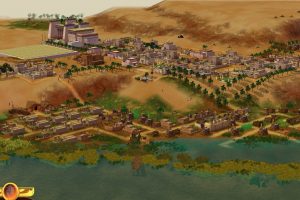
And finally, something that would, in my opinion, really add to the realism and historical flavor of a medieval-themed city builder would be the introduction of mechanisms in which agricultural surpluses are skimmed by the church and the feudal lord. Tithes, taxes and rents! Instead of merely abstracting the taxes into an income modifier or letting the player be the extractor himself, we could be shown the tax collector visiting the village, counting the sheaves by the side of the road, selecting the calves and chickens. This way, the experiences of our medieval forebears are visualized and may help to educate the public about medieval village life.
Why not?
There are some good reasons why city building games are not that historically accurate and instead adhere to the established formula of the city building game.
First of all, a linear growth model makes sense from a gameplay perspective, since it is rewarding to see your settlement grow.in a linear way. It fosters a feeling of progress and motivates the player to keep momentum and push through to the next expansion phase. Secondly, games are generally wary of punishing failure too harshly in order to avoid demoralizing the player. Thirdly, in order to facilitate path finding for the simulated villagers it is easier to implement a gridlike road and building system rather than an off-grid building system that allows for curvy roads. So far only Cities Skylines has managed to do this in a satisfactory way.
Lastly, for marketing purposes and recognizability, game developers generally don't stray too far from the image of the Middle Ages that the public is already acquainted with. For a medieval city builder this means windmills, industrious peasants, lots of sheep and stone castles. Things like land surveying, crop rotation and tithe collection do not fit this image and challenge the romanticized picture of the uneducated farmer in his pre-industrial environment.
Conclusion
Although I think medieval-themed city building games could benefit from incorporating some of the things we know about medieval settlement history into the gameplay loop, it may not be desirable for game developers to stray too far from the established formula. The idea that medieval settlements developed organically according to messy road plans is strongly imbedded in popular perception. Allowing both straight and curved road building in medieval city builders, may serve to challenge some of the stereotypes that exist about medieval village life. And if you ask me, that would be a good thing for it is an enriching experience to see the world through the eyes of our medieval forebears. One may find out that their lives were not that different after all...
Further reading
- Fossier, R. (2004). “The Rural Economy and Demographic Growth.” In: D. Luscombe & J. Riley-Smith (Eds.). The New Cambridge Medieval History. Cambridge: Cambridge University Press, 11-46.
- Van Ham, W. (1979). “Dorp en dorpsleven in middeleeuws Wouw." in: A. Delahaye (red.), De Heren XVII van Nassau-Brabant, 316-336.”
- (forthc.) Kerkhof, P.A. (2020). “Saer, Saert; een Zuid-Nederlandse veldnaam van onzekere oorsprong.” Noordbrabants Historisch Jaarboek.
- Leenders, K.A.H.W. (1996). "Noord-Vlaanderen en de Noordwesthoek; een vergelijking." Tijdschrift voor Waterstaatsgeschiedenis 5, 67-73.
- Leenders, K.A.H.W. (1989). Verdwenen venen; een onderzoek naar de ligging en exploitatie van thans verdwenen venen in het gebied tussen Antwerpen, Turnhout, Geertruidenberg en Willemstad (1250-1750). Reeks Landschapsstudies 13, Wageningen.
- Oosthuizen, S. (2017). The Anglo-Saxon fenland. Windgather Press.
© Peter Alexander Kerkhof and Leiden Medievalists Blog, 2020. Unauthorised use and/or duplication of this material without express and written permission from this site’s author and/or owner is strictly prohibited. Excerpts and links may be used, provided that full and clear credit is given to Peter Alexander Kerkhof and Leiden Medievalists Blog with appropriate and specific direction to the original content.


